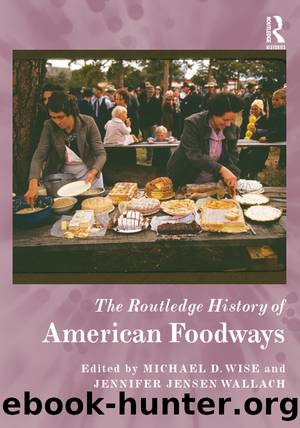The Routledge History of American Foodways by unknow

Author:unknow
Language: eng
Format: epub
Tags: Nonfiction, History, Reference, Americas, United States
ISBN: 9781317975229
Publisher: Taylor and Francis
Published: 2016-02-12T05:00:00+00:00
Theme 5: Control (Chaos vs. Control)
A final theme is the need to somehow constrain the public and individual excesses that often occur during holiday celebrations. This reflects notions of citizenship and morality and is played out in the dialectics between public and private, outdoors and indoors, and adults and children. The concept of the family is central to this theme, and many holiday foodways have been anchored to family tradition as a way of âtamingâ excess, chaos, and harmful or destructive behavior. This has been particularly true of those holidays, such as Halloween and Mardi Gras, that function as rituals of reversal, but any holiday can include components that are problematic. Alcohol consumption, in particular and not unexpectedly, has been the focus of many calls for control within almost every holiday of any type celebrated.
Excess has shown up historically in surprising ways in holidays that now seem quite tame. In the Colonial era and early days of the Republic, public celebrations of any holiday tended to be male-only and held in taverns or other such venues where alcohol was plentiful.32 Patriotic celebrations, such as days commemorating Independence, were particularly problematic, frequently involving unruly crowds of young men gathering for the parades, speeches, and dinners accompanying these celebrations. While there do not seem to have been specific foods expected at the dinners, the giving of toasts was a primary activity, and required alcohol, such as hard cider, ale, and beer. Christmas and New Yearâs, similarly, involved a great deal of visiting and sharing of food and drink, resulting again in drunken and unruly behavior. As a new nation, the moral character of its citizenry was a great concern, and attempts were made to âdomesticate the Revolutionâ by codifying holidays and the foods associated with them.33 Some patriotic celebrations, then, became more formal events. Election days, for example, are now associated with food traditions specific to their regions, such as New England election day cakes and bean suppers.
While excessive indulgence in food and alcohol continue to characterize many holidays into the present, these early attempts did succeed in shifting many holiday celebrations to the home, partly because they coincided with a romanticization of the family in the early 1800s.34 Family meals became an established ritual in many holidays, particularly Thanksgiving, Christmas, and Easter, and the latter two also developed foodways traditions around children, with special candies and treats and rituals of giving those foods.
Two holidays stand out in the theme of control: Halloween and Mardi Gras. Halloween, as mentioned earlier, was brought by Irish immigrants, but became in the latter nineteenth century and early twentieth century as a time of pranks and mischief, and by the 1930s, those had escalated to the point of concern. In response, civic leaders began emphasizing it as a child-centered holiday, so that in the 1950s, a more innocuous custom of trick-or-treating was established in many cities and suburbs. One of the goals of trick-or-treating, however, is to acquire an abundance of candy. Consuming that excess frequently
Download
This site does not store any files on its server. We only index and link to content provided by other sites. Please contact the content providers to delete copyright contents if any and email us, we'll remove relevant links or contents immediately.
| Africa | Americas |
| Arctic & Antarctica | Asia |
| Australia & Oceania | Europe |
| Middle East | Russia |
| United States | World |
| Ancient Civilizations | Military |
| Historical Study & Educational Resources |
Machine Learning at Scale with H2O by Gregory Keys | David Whiting(4183)
Never by Ken Follett(3791)
Fairy Tale by Stephen King(3220)
The Man Who Died Twice by Richard Osman(2997)
Oathbringer (The Stormlight Archive, Book 3) by Brandon Sanderson(2881)
Will by Will Smith(2793)
Rationality by Steven Pinker(2291)
The Dark Hours by Michael Connelly(2243)
Can't Hurt Me: Master Your Mind and Defy the Odds - Clean Edition by David Goggins(2228)
The Dawn of Everything: A New History of Humanity by David Graeber & David Wengrow(2122)
Friends, Lovers, and the Big Terrible Thing by Matthew Perry(2119)
Principles for Dealing With the Changing World Order: Why Nations Succeed and Fail by Ray Dalio(1974)
HBR's 10 Must Reads 2022 by Harvard Business Review(1777)
A Short History of War by Jeremy Black(1762)
Go Tell the Bees That I Am Gone by Diana Gabaldon(1687)
515945210 by Unknown(1599)
A Game of Thrones (The Illustrated Edition) by George R. R. Martin(1589)
Kingdom of Ash by Maas Sarah J(1526)
443319537 by Unknown(1470)
